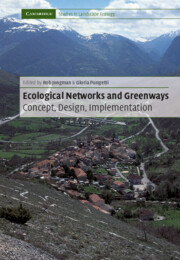Book contents
- Frontmatter
- Contents
- List of contributors
- Foreword
- Preface
- Acknowledgements
- 1 Introduction: ecological networks and greenways
- 2 The context and concept of ecological networks
- 3 Greenways in the USA: theory, trends and prospects
- 4 Ecological functioning of ecological networks: a species perspective
- 5 Impacts of roads on ecological networks and integration of conservation and transportation planning: Florida as a case study
- 6 Ecological corridors on a European scale: a typology and identification of target species
- 7 Planning the future landscape between nature and culture
- 8 From models to reality: design and implementation process
- 9 Design of the Pan-European Ecological Network: a national level attempt
- 10 Ecological ‘black spots’ within the ecological network: an improved design for rural road network amelioration
- 11 An ecological network for the Milan region based on focal species
- 12 Connecting corridors: implementing metropolitan greenway networks in North America
- 13 The Florida Statewide Greenways Project: its realisation and political context
- 14 The ecological network development in the Yungas, Argentina: planning, economic and social aspects
- 15 The river corridor of the Guadiamar
- 16 Conclusions: into the twenty-first century
- References
- Index
6 - Ecological corridors on a European scale: a typology and identification of target species
Published online by Cambridge University Press: 29 December 2009
- Frontmatter
- Contents
- List of contributors
- Foreword
- Preface
- Acknowledgements
- 1 Introduction: ecological networks and greenways
- 2 The context and concept of ecological networks
- 3 Greenways in the USA: theory, trends and prospects
- 4 Ecological functioning of ecological networks: a species perspective
- 5 Impacts of roads on ecological networks and integration of conservation and transportation planning: Florida as a case study
- 6 Ecological corridors on a European scale: a typology and identification of target species
- 7 Planning the future landscape between nature and culture
- 8 From models to reality: design and implementation process
- 9 Design of the Pan-European Ecological Network: a national level attempt
- 10 Ecological ‘black spots’ within the ecological network: an improved design for rural road network amelioration
- 11 An ecological network for the Milan region based on focal species
- 12 Connecting corridors: implementing metropolitan greenway networks in North America
- 13 The Florida Statewide Greenways Project: its realisation and political context
- 14 The ecological network development in the Yungas, Argentina: planning, economic and social aspects
- 15 The river corridor of the Guadiamar
- 16 Conclusions: into the twenty-first century
- References
- Index
Summary
Introduction
The ongoing fragmentation of natural and semi-natural areas in Europe and the development of related concepts in population dynamics and landscape ecology in recent decades has raised awareness of the role that connectivity and permeability of landscapes play in maintaining viable natural populations. Since the publication of the ‘island theory’ by MacArthur and Wilson (1967) several studies have shown that populations are affected by the spatial configuration of their habitat. The metapopulation concept has been accepted by landscape ecologists as an adequate way to describe the relationship between size and connectivity of habitat patches and population persistence.
One of the questions regarding permeability of the landscape for species is whether species require specific landscape structures to move from one suitable habitat patch to another. Within the ecological network concept these ‘structures’ are referred to as corridors. Within ecological networks ecological corridors are various landscape structures, other than core areas, in size and shape varying from wide to narrow and from meandering to straight, which represent links that permeate the landscape, maintaining or re-establishing natural connectivity (Jongman and Troumbis 1995). Within an ecological network, corridors could be multi-functional landscape structures.
In Europe, ecological corridors are often the result of human intervention in nature: hedgerows, stonewalls, landscapes with small forests, canals and regulated rivers. The nature of ecological corridors and their efficiency in interconnecting remnants and in permeating the landscape depend on the habitat site they originate from and the land use mosaic within which they are embedded and of which they consist (Forman 1983).
- Type
- Chapter
- Information
- Ecological Networks and GreenwaysConcept, Design, Implementation, pp. 94 - 106Publisher: Cambridge University PressPrint publication year: 2004
- 3
- Cited by

